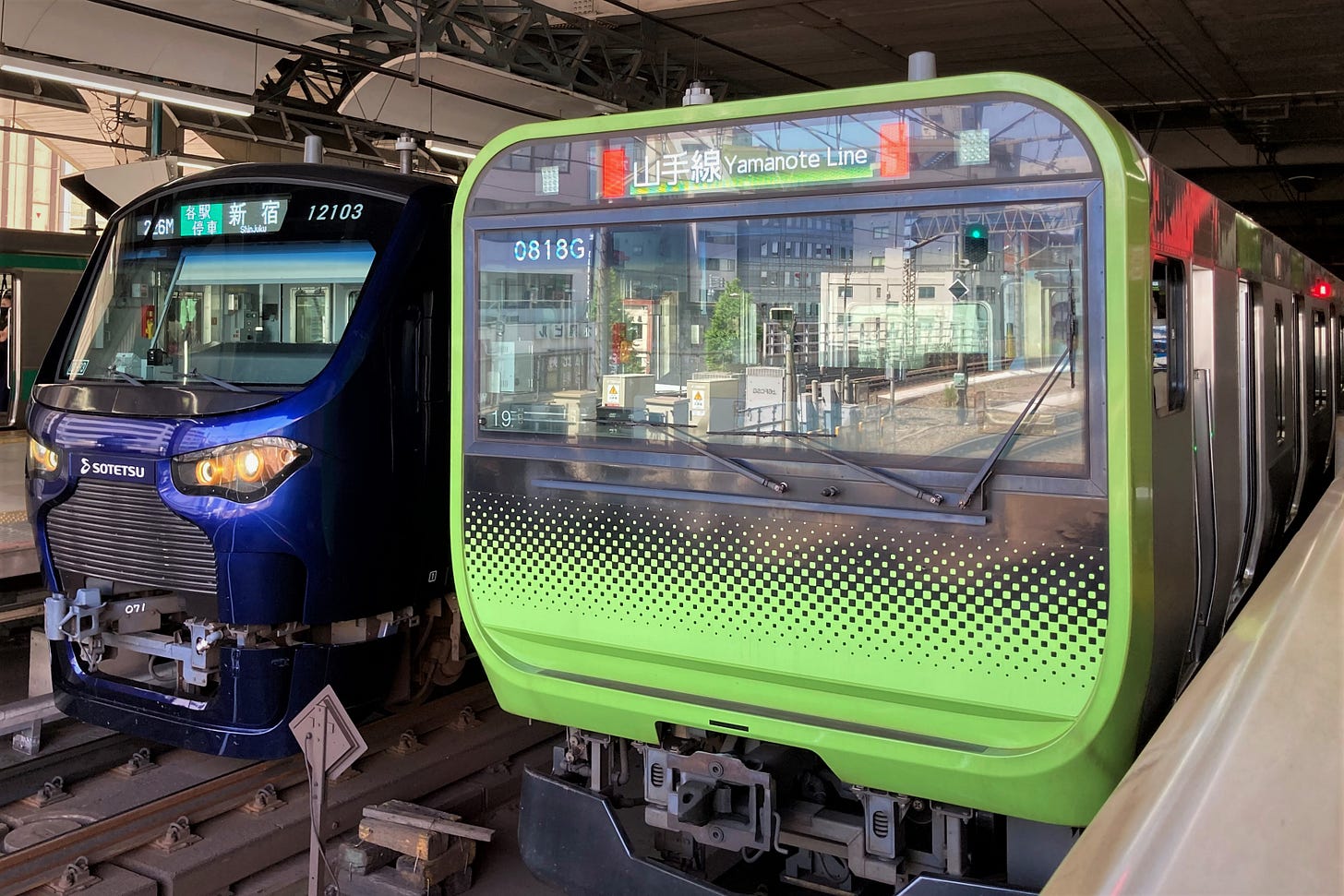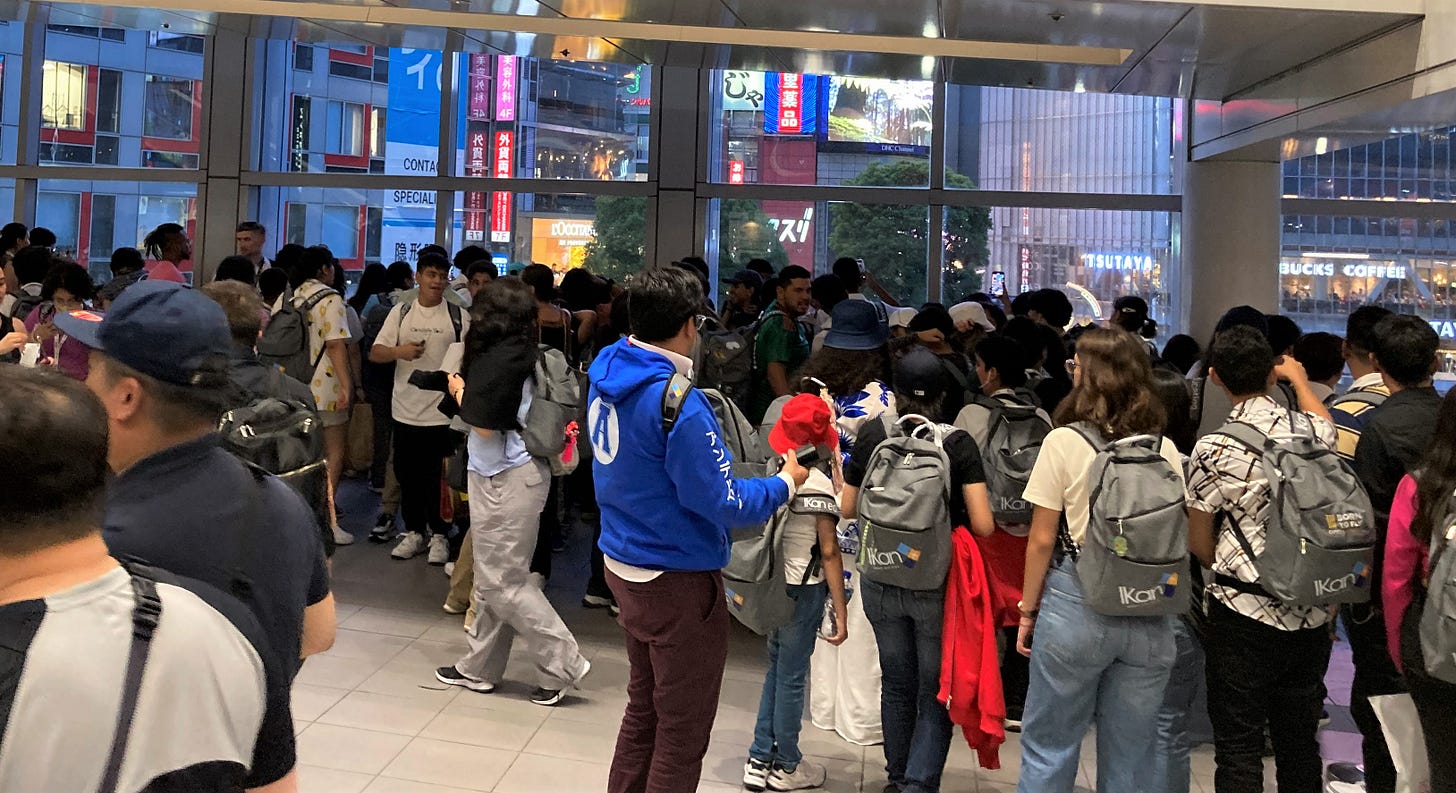#56 the Yamanote Line
An insider’s guide to navigating Tokyo’s famous circular line – from key landmarks to quirky station jingles
Time flies; it’s already been three weeks since my last post. I hope you’ve all been well! I just returned from a business trip in Pakistan and am now back in Japan. The southern region of Pakistan was sweltering, with intense humidity and temperatures soaring up to 44 °C (111°F). Now, in Japan, I'm greeted by the gentle spring weather, a soothing 20°C (68°F). I must admit, it feels refreshing to be back.
Anyway, let’s dive into this week’s topic: the Yamanote Line, the famous circular line of Tokyo.
When traveling, figuring out the public transport system is crucial, especially when you’re unfamiliar with the city. When I lived in London more than ten years ago, I didn’t feel at home until I understood the tube system completely.
If you're visiting Tokyo for the first time, the transport system might seem too complex and daunting. But knowing just a few things could not only make it much easier for you to navigate the metropolis but also enjoy the ride along the way.
This week I will focus on the Yamanote Line (JR East) which is a circular loop line in Tokyo. It’s one of the busiest and most important lines, connecting different metro lines and major city centers.

What is the Yamanote Line?
Name origin
The name "Yamanote Line" literally translates to "the area on the hillside," referring to the higher ground on which the line runs. The Yamanote Line opened in 1885 but it was not until 1925 that the circular line as we know it today was formed.
A unique circular line
There are many cities worldwide that have a circular railroad system, such as London’s Circle Line, Berlin’s Ringbahn, and Moscow’s Koltsevaya Line to name a few.1 The Yamanote Line is one of them. It is 34.5 km long, has 30 stations, and takes about an hour to travel. Trains depart every 2 minutes in both directions (even shorter intervals during rush hour) and run from 4:30 am to 1 am. Supposedly you fall asleep on the train, and you wake up yourself after one hour, you will find yourself at the same station without noticing that the time has passed!
Where is the train depot?
Since it’s a circular line, you may be wondering — where is the train depot? Of course, the operator JR East doesn’t leave all the trains on the rail all day. There is a train depot at Osaki, which is a station between Shinagawa and Gotanda. You sometimes encounter a train that terminates at Osaki Station, otherwise, the train will keep running either clockwise or anticlockwise every few minutes.
Must-see tourist attractions along the Yamanote Line
The following list will show you how the Yamanote Line covers the major tourist attractions in Tokyo.
Listed from Tokyo Station clockwise
Yurakucho: The gateway to Ginza (high-end shopping district)
Shinbashi: Oasis of Japanese businessmen, cheap eats
Shinagawa: Hub station for various JR lines, bullet trains, and transport to Airport
Osaki: The Yamanote Line train depot
Shibuya: Shibuya Crossing(Japan A to Z #55)
Harajuku: Meiji Jingu Shrine, Takeshita Street
Shinjuku: Major train terminal westbound, Shinjuku Gyoen Park
Shin-Okubo: Korean town in Tokyo
Ikebukuro: Ikebukuro Otome Road
Nippori: Old Tokyo Yanaka shopping arcade
Akihabara: Sub-culture and anime
Tips for making the most of the Yamanote Line
Traveling vertically in the center of Tokyo: The Yamanote Line is convenient when combined with the Keihin-Tohoku Line as they run parallel from Tabata to Shinagawa, allowing for easy transfers and increased connectivity and frequency.

Source: japan-guide.com Buying Tokyo Ward one-day pass (covered in my #14 post): If you don’t have a JR pass, the Tokyo Ward one-day pass (760 yen /$5.5) is a good alternative. The pass will give you more freedom to get around in central Tokyo including the Yamanote Line.
Train departure jingles
When I’m showing visitors around on train platforms, I’m frequently asked about the sounds of birds singing or various departure jingles. Previously, there were ringing bells to signal train departures, but they were eventually replaced by melodies. The Yamanote Line is especially famous for having a unique jingle for each station, reflecting the surrounding area's character or history. These melodies differ from station to station, even on the platforms. You can listen to the melodies for each station of the Yamanote Line in the video below:
Many jingles feature songs that reflect the characteristics of the station, for example, Takadanobaba station’s jingle is from the theme song of Astro Boy, a popular manga series by Osamu Tezuka. (In the story, Astro Boy is born/created in Takadanobaba.)
Unique jingles evoke specific emotional reactions towards the places we often visit, and can be nostalgic to the Japanese people. This is also how we remember to get off at the right station!
If you are curious to learn more about the transport system, let me know in the comments below! If you like trains, you might enjoy
writes about the Japanese railway. also writes a few insightful articles about Japan’s Rail Network. Love Public Transit from also has a few nice posts about trains in Japan!*Shibuya Crossing Update*
In my previous post, I wrote about the Shibuya Crossing, and this week, I passed by one of the observing points I mentioned and this is what I saw:
Did they all read my previous post? I find Shibuya as a whole more and more crowded with foreign visitors every time I visit. If you want to take photos calmly, you may have to pick up the timing. Late afternoon to the evening would be too busy.
METRO RINGS AND LOOPS - blog post about various circular lines and loops around the world of all shapes and sizes. Very well documented.






